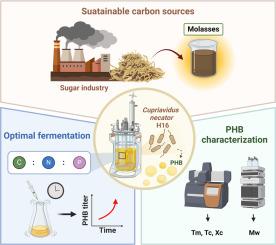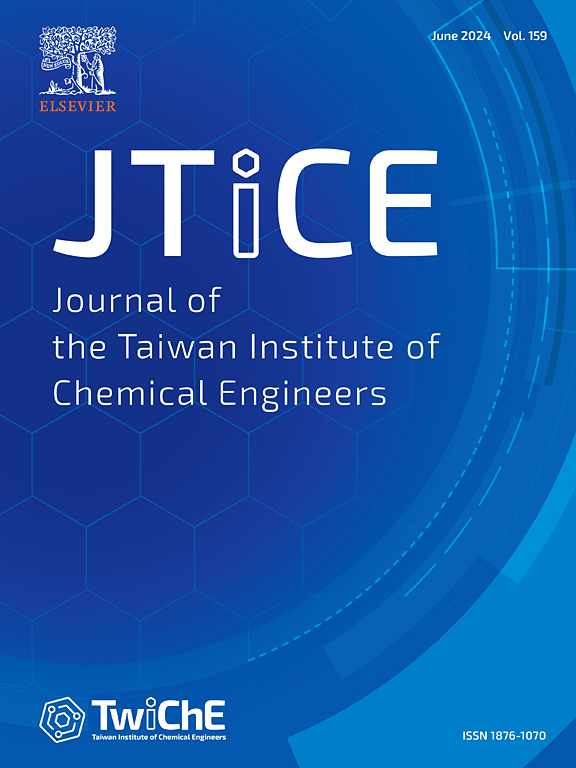利用废糖蜜制备聚羟基丁酸盐(PHB)
IF 5.5
3区 工程技术
Q1 ENGINEERING, CHEMICAL
Journal of the Taiwan Institute of Chemical Engineers
Pub Date : 2024-11-30
DOI:10.1016/j.jtice.2024.105843
引用次数: 0
摘要
cupriavidus necator H16是一种天然的聚羟基丁酸酯(PHB)生产商,已成为替代传统塑料的有前途的可持续生物生产候选者。然而,大多数发酵过程仍然依赖于昂贵的底物。因此,开发一种利用废物的生态友好型PHB生物工艺是迫切和必要的。方法采用含有半乳糖渗透酶(galP)和葡萄糖激酶(glk)的工程菌株gg- h16促进葡萄糖摄取和磷酸化。然后,通过微调碳、氮、磷比例来提高生物量和PHB产量。添加酵母提取物作为额外的营养物质,并采用量身定制的饲养策略,以最大限度地提高PHB的产量。为了降低生产成本,利用制糖业的废糖蜜进行补料分批发酵。采用差示扫描量热仪(DSC)和凝胶渗透色谱法(GPC)分析了PHB的分子量和结晶度等物理性质。显著结果当C:N:P比为20:1:18时,在培养基中添加2 g/L酵母提取物时,工程菌株的特定生长率比野生型提高了2.15倍。利用雾化器对废糖蜜进行补料分批发酵以增加气体分散,PHB产率达到17.4 g/L,成本仅为药用级葡萄糖的1%。由lg - h16生产的PHB的所有物理性能都与商业产品相当,这为使用低成本原料生产高价值生物塑料PHB的生物工艺提供了支持。本文章由计算机程序翻译,如有差异,请以英文原文为准。

Biofabrication of polyhydroxybutyrate (PHB) in engineered Cupriavidus necator H16 from waste molasses
Background
Cupriavidus necator H16, a native polyhydroxybutyrate (PHB) producer, has emerged as a promising candidate for sustainable bioproduction to replace conventional plastics. However, most fermentation processes still rely on expensive substrates. Therefore, developing an eco-friendly bioprocess for PHB using waste materials is urgent and essential.
Method
An engineered strain Lgg-H16, incorporating galactose permease (galP) and glucokinase (glk), was employed to boost glucose uptake and phosphorylation. Then, biomass and PHB production were improved by fine-tuning the carbon, nitrogen, and phosphorus ratios. Yeast extract was supplemented as an additional nutrient, and a tailored feeding strategy was applied to maximize PHB output. To lower the manufacturing costs, waste molasses from the sugar industry, was utilized for fed-batch fermentation. The physical properties of the PHB, such as molecular weight and crystallinity, were analyzed using differential scanning calorimeter (DSC) and gel permeation chromatography (GPC), respectively.
Significant results
Engineered Lgg-H16 strain exhibited a 2.15-fold increase in specific growth rate compared to the wild type with a C:N:P ratio of 20:1:18, as well as supplemented 2 g/L yeast extract in the medium. PHB yield reached 17.4 g/L with 70 % content from waste molasses in fed-batch fermentation with an atomizer to increase gas dispersion, costing only 1 % of pharmaceutical-grade glucose. All physical properties of the PHB produced by Lgg-H16 were comparable to commercial product, supporting this promising bioprocess by using the low-cost feedstocks for high-value bioplastic PHB.
求助全文
通过发布文献求助,成功后即可免费获取论文全文。
去求助
来源期刊
CiteScore
9.10
自引率
14.00%
发文量
362
审稿时长
35 days
期刊介绍:
Journal of the Taiwan Institute of Chemical Engineers (formerly known as Journal of the Chinese Institute of Chemical Engineers) publishes original works, from fundamental principles to practical applications, in the broad field of chemical engineering with special focus on three aspects: Chemical and Biomolecular Science and Technology, Energy and Environmental Science and Technology, and Materials Science and Technology. Authors should choose for their manuscript an appropriate aspect section and a few related classifications when submitting to the journal online.

 求助内容:
求助内容: 应助结果提醒方式:
应助结果提醒方式:


